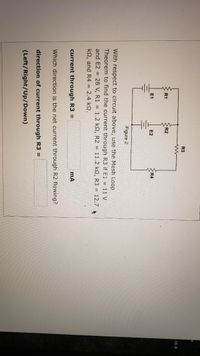
Introductory Circuit Analysis (13th Edition)
13th Edition
ISBN: 9780133923605
Author: Robert L. Boylestad
Publisher: PEARSON
expand_more
expand_more
format_list_bulleted
Concept explainers
Question

Transcribed Image Text:R3
.15.4
R1
R2
E2
R4
Figure 2
With respect to circuit above, use the Mesh Loop
Theorem to find the current through R3 if E1 = 11 V
and E2 = 28 V, R1 = 1.2 k2, R2 = 11.2 k2, R3 = 12.7
k2, and R4 = 2.4 k2.
current through R3 =
Which direction is the net current through R2 flowing?
direction of current through R3 =
(Left/Right/Up/Down)
Expert Solution
This question has been solved!
Explore an expertly crafted, step-by-step solution for a thorough understanding of key concepts.
Step by stepSolved in 2 steps with 2 images

Knowledge Booster
Learn more about
Need a deep-dive on the concept behind this application? Look no further. Learn more about this topic, electrical-engineering and related others by exploring similar questions and additional content below.Similar questions
- Can you explain how you got the 25 for I when calculating p3?arrow_forwardConsider the following resistor network: i₁ = E A, 1₂ = Voltage gain across I is b. Report the voltage gain across the current source I. (Click on the image to enlarge) Suppose R₁ = 60, R₂ = 50, R3 = 142, R₁ = 4, R5 = 4N, E = 28V and I = 6A. Set up and solve a linear system for the loop currents and the voltage across the current source as shown in the online notes. a. Report the loop currents i1, 12 and i3 (positive for clockwise direction). V R₁ A, 23 = R₂. R3 R4 A R5arrow_forwardIn step 3, was the potential at the high side of D2, ‘pulled’ higher or lower, relative to ground, by the jumper wiresarrow_forward
- question 3,4,5,6 pleasearrow_forwardI need part Barrow_forwardIn the figure, 8 = 138 V, R₁ = 10.702, R₂ = 29.402, R3 = 34.3 02, and L = 1.74 H. Immediately after switch S is closed, what are (a) i₁ and (b) i2? (Let currents in the indicated directions have positive values and currents in the opposite directions have negative values.) A long time later, what are (c) i₁ and (d) i2? The switch is then reopened. Just then, what are (e) i₁ and (f) i₂? A long time later, what are (g) i₁ and (h) i₂? (a) Number i (b) Number i (c) Number i (d) Number i (e) Number i Units Units Units Units Units R₁ R$ R₂ Larrow_forward
arrow_back_ios
arrow_forward_ios
Recommended textbooks for you
 Introductory Circuit Analysis (13th Edition)Electrical EngineeringISBN:9780133923605Author:Robert L. BoylestadPublisher:PEARSON
Introductory Circuit Analysis (13th Edition)Electrical EngineeringISBN:9780133923605Author:Robert L. BoylestadPublisher:PEARSON Delmar's Standard Textbook Of ElectricityElectrical EngineeringISBN:9781337900348Author:Stephen L. HermanPublisher:Cengage Learning
Delmar's Standard Textbook Of ElectricityElectrical EngineeringISBN:9781337900348Author:Stephen L. HermanPublisher:Cengage Learning Programmable Logic ControllersElectrical EngineeringISBN:9780073373843Author:Frank D. PetruzellaPublisher:McGraw-Hill Education
Programmable Logic ControllersElectrical EngineeringISBN:9780073373843Author:Frank D. PetruzellaPublisher:McGraw-Hill Education Fundamentals of Electric CircuitsElectrical EngineeringISBN:9780078028229Author:Charles K Alexander, Matthew SadikuPublisher:McGraw-Hill Education
Fundamentals of Electric CircuitsElectrical EngineeringISBN:9780078028229Author:Charles K Alexander, Matthew SadikuPublisher:McGraw-Hill Education Electric Circuits. (11th Edition)Electrical EngineeringISBN:9780134746968Author:James W. Nilsson, Susan RiedelPublisher:PEARSON
Electric Circuits. (11th Edition)Electrical EngineeringISBN:9780134746968Author:James W. Nilsson, Susan RiedelPublisher:PEARSON Engineering ElectromagneticsElectrical EngineeringISBN:9780078028151Author:Hayt, William H. (william Hart), Jr, BUCK, John A.Publisher:Mcgraw-hill Education,
Engineering ElectromagneticsElectrical EngineeringISBN:9780078028151Author:Hayt, William H. (william Hart), Jr, BUCK, John A.Publisher:Mcgraw-hill Education,

Introductory Circuit Analysis (13th Edition)
Electrical Engineering
ISBN:9780133923605
Author:Robert L. Boylestad
Publisher:PEARSON

Delmar's Standard Textbook Of Electricity
Electrical Engineering
ISBN:9781337900348
Author:Stephen L. Herman
Publisher:Cengage Learning

Programmable Logic Controllers
Electrical Engineering
ISBN:9780073373843
Author:Frank D. Petruzella
Publisher:McGraw-Hill Education

Fundamentals of Electric Circuits
Electrical Engineering
ISBN:9780078028229
Author:Charles K Alexander, Matthew Sadiku
Publisher:McGraw-Hill Education

Electric Circuits. (11th Edition)
Electrical Engineering
ISBN:9780134746968
Author:James W. Nilsson, Susan Riedel
Publisher:PEARSON

Engineering Electromagnetics
Electrical Engineering
ISBN:9780078028151
Author:Hayt, William H. (william Hart), Jr, BUCK, John A.
Publisher:Mcgraw-hill Education,